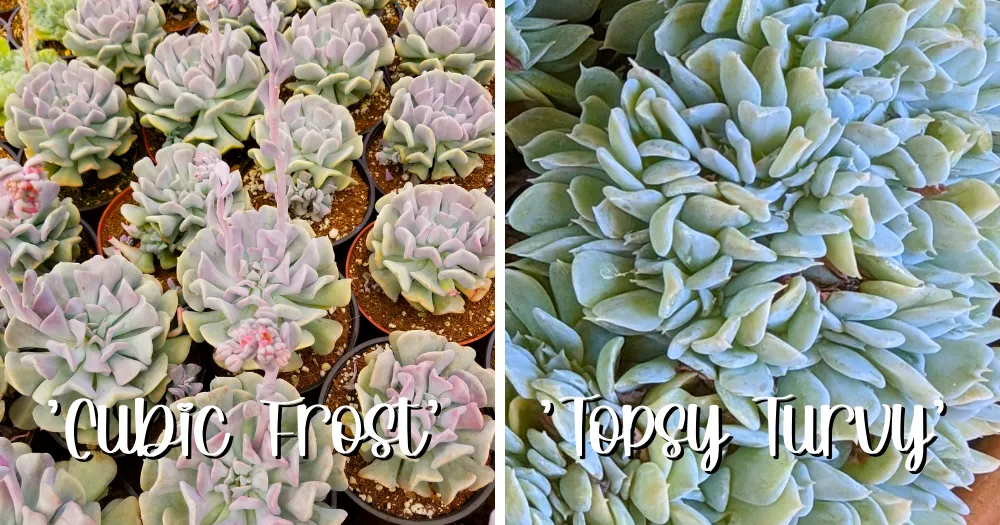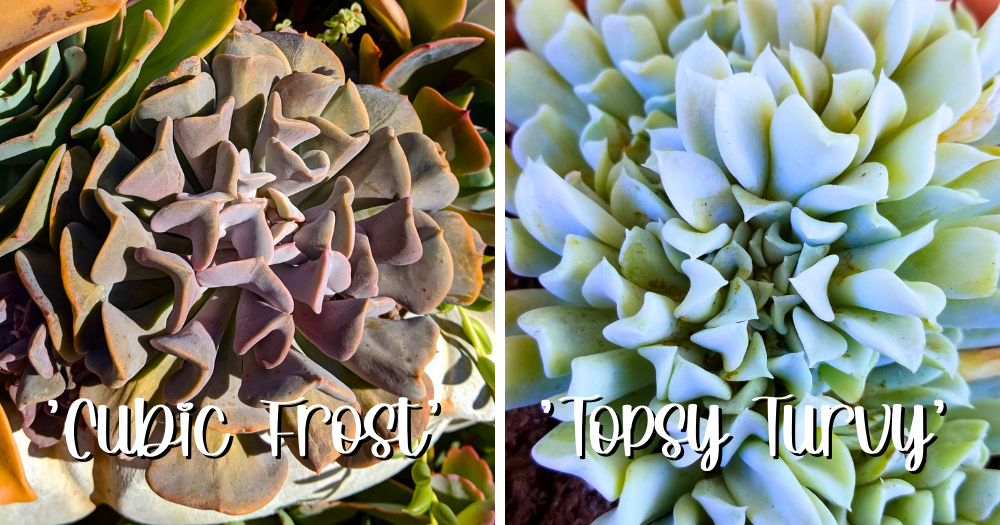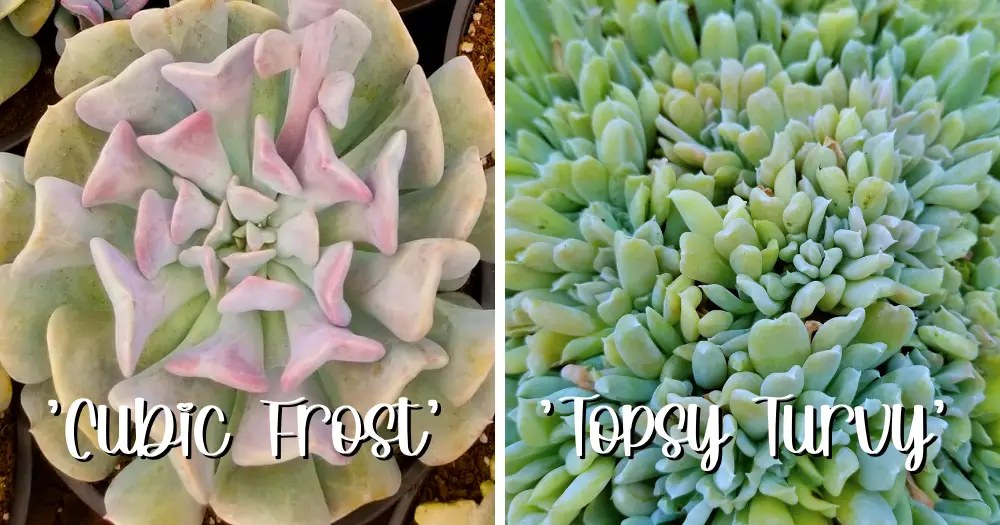Echeveria ‘Cubic Frost’ and Echeveria ‘Topsy Turvy’ are two popular cultivars of Echeveria succulents that can be difficult to distinguish from one another. However, there are several key characteristics that differentiate these two varieties. Keep reading and you’ll be able to confidently tell them apart.
Dig in!

Form
One of the most notable differences is the shape of their rosettes. Echeveria ‘Cubic Frost’ exhibits a tightly formed rosette shape with leaves that are arranged in a very orderly, geometric pattern, whereas Echeveria ‘Topsy Turvy’ has a looser, more casually arranged rosette with longer, more loosely held leaves.
You might also like: 9 Stunningly Realistic LEGO Succulents in a Set to Transform Your Home Decor and Have Fun While Building It

Color
Another significant way in which these two Echeveria cultivars differ is the color of their foliage. Echeveria ‘Cubic Frost’ displays leaves that are colored in shades of lilac and pink, presenting a very different appearance than the greyish-green hues of the foliage of Echeveria ‘Topsy Turvy’.
You might also like: 9 Ravishing Red Succulents and Where to Buy These Stunning Beauties

Producing Offsets
Furthermore, Echeveria ‘Cubic Frost’ has the ability to produce offsets, or new rosettes connected by stems, much more freely and at a younger age than Echeveria ‘Topsy Turvy’. The prolific offsetting of Echeveria ‘Cubic Frost’ allows it to form attractive clusters and spread more rapidly, while Echeveria ‘Topsy Turvy’ only produces offsets occasionally and not as prolifically, nor at a young age.
You might also like: Monocarpic Succulents: The Ultimate Guide to Growing and Caring for These Unique Plants and 4 Ways You Might Be Able to Save Yours From a Death Bloom

Growth Rate
Finally, Echeveria ‘Cubic Frost’ has a faster overall growth rate than Echeveria ‘Topsy Turvy’. Combined with its free-offsetting nature, this gives Echeveria ‘Cubic Frost’ the ability to produce new plants more quickly and have shorter intervals between propagation generations. In contrast, the slower growth and less prolific offsetting of Echeveria ‘Topsy Turvy’ results in longer production and propagation times.
You might also like: How to Make Succulents Grow Faster: 5 Easy Tips and Techniques

Do Echeveria ‘Cubic Frost’ and Echeveria ‘Topsy Turvy’ require different care or growing conditions?
Echeveria ‘Cubic Frost’ and Echeveria ‘Topsy Turvy’ have similar care requirements, but there are some differences to be aware of:
Light: Both varieties need bright light, but Echeveria ‘Cubic Frost’ can tolerate a bit more shade than Echeveria ‘Topsy Turvy’ which prefers more direct sunlight.
You might also like: How Much Light Do Succulents Need? A Comprehensive Guide in 12 Parts
Water: Water the plants deeply, but let the soil dry out between waterings. Echeveria ‘Cubic Frost’ is a bit more tolerant of moisture than Echeveria ‘Topsy Turvy’, so be careful not to overwater the latter.
You might also like: How & When to Water Succulents So They Don’t Die (2023 Update)
Temperature: They can tolerate similar temperatures, down to 30 F. However, Echeveria ‘Cubic Frost’ is a bit more cold hardy and can handle slightly cooler temperatures down to 25 F.
You might also like: How to Behead an Echeveria and Cut Off Bloom Stalks: An Easy 6 Step How-To Guide
Soil: Use a well-draining cactus potting mix. Echeveria ‘Topsy Turvy’ prefers a grittier mix to ensure good drainage and prevent root rot.
You might also like: Succulent Soil: Ultimate Guide & 4 DIY Recipes to Keep Your Succulents Happy and Healthy
Fertilizer: Fertilize lightly during the growing season. Echeveria ‘Topsy Turvy’ has lower fertility needs and does not require as much fertilizer as Echeveria ‘Cubic Frost’.
You might also like: Succulent Fertilizer: The Ultimate Guide to Healthy Succulents + 8 DIY Fertilizer Recipes
The care requirements are similar but Echeveria ‘Topsy Turvy’ has higher light needs and lower tolerance for moisture, requiring a grittier soil mix and less fertilizer. Being aware of these differences can help ensure that your Echeverias live their best life.

Can I propagate these succulents by leaf cuttings?
Yes, both Echeveria ‘Cubic Frost’ and Echeveria ‘Topsy Turvy’ can be propagated by leaf cuttings.
Here are the steps:
- Select a healthy leaf from the outer portion of the rosette. The leaf should be mature but not old.
- Gently twist and remove the leaf from the stem. Allow it to dry out for a day or two so the cut end can seal.
- Dip the cut end of the leaf in rooting hormone (optional). This can help promote root growth.
- Place the leaf in well-draining rooting medium, such as perlite or a sand-peat mix. Bury the cut end in the soil, leaving the leaf blade exposed.
- Keep the medium moderately moist and place in a bright spot out of direct sunlight.
- Roots should form in 1-2 months. Once the new plant is a few inches tall, it can be transplanted.
You might also like: Succulent Propagation Timeline
Both Echeveria varieties can produce many new plants from a single leaf. However, Echeveria ‘Cubic Frost’ tends to produce offsets from leaf cuttings more prolifically than Echeveria ‘Topsy Turvy’. With the proper care, leaf cuttings can be an easy way to multiply your echeveria collection.
You might also like: Propagating Succulents 4 Ways: The Best Guide Ever
While Echeveria ‘Cubic Frost’ and Echeveria ‘Topsy Turvy’ are both popular echeveria cultivars, they can be differentiated based on the shape and color of their rosettes, as well as their growth and propagation rates. Recognizing these distinguishing characteristics can be helpful in identifying and choosing between these two varieties for cultivation or display.
For more succulents that are hard to tell apart, click here.

Where to Buy Succulents Online


